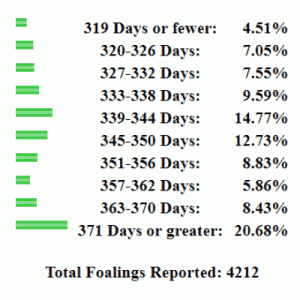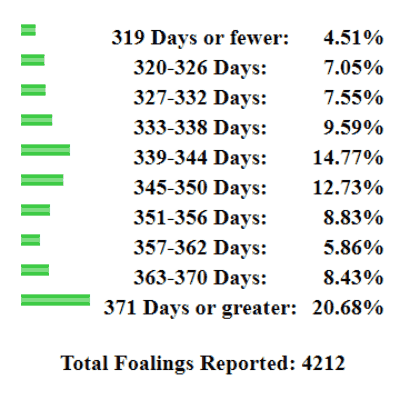Is my mare overdue?
By Jos Mottershead
Note: Please review the statistics at the foot of this page. If you have gestational duration information on your born-live colt or filly foal, please add it and assist us in creating a more detailed report for viewers relative to duration, based upon the sex of their foal. Thank you!
One of the most commonly asked questions of the foaling season is “Is my mare overdue?”. This is often precipitated by the misbelief that 340 or 341 days of pregnancy duration represent a “due date”. Not so!
The average duration of gestation is anywhere between 320 and 370 days – so that mare which is at 345 days is not “overdue”, but well within the normal range! The foaling date is picked by the foal who dictates that he or she is sufficiently developed and ready to be born, not by the mare who is watching the calendar on the wall!
Note too that the terms “premature”, “dysmature” and “postmature” refer to the condition of the foal at birth and not to the gestational duration.
Here are some important facts to consider about gestational lengths:
- Foals born prior to 300 days are unlikely to be viable.
- Their lungs are not fully developed and they will not be able to breath.
- Unlike similar premature situations with humans, the use of a surfactant in the foal to assist with development and breathing has not proven succesful.
- Note that this is referencing a normal, healthy pregnancy. Mares that manage to support a pregnancy threatened by something such as placentitis to term may have shorter-than-“normal” pregnancy duration, and yet still present a viable foal. It is unusual that the gestational period will be lower than 300 days in this case, but it can happen. This is thought to be as a result of elevated cortisol levels – due to fetal stress – causing accelerated fetal development.
- It should be noted that considerably shorter Miniature Horse pregnancies (~280 days) have resulted in healthy foals.
- Their lungs are not fully developed and they will not be able to breath.
- Foals born after 300 days but prior to 320 days are at risk of being born in a premature condition.
- Premature foals will require neonatal intensive care;
- The closer to 300 days the foaling, the more intensive the needed care will be;
- Foals born from mares that suffered from infectious placentitis during pregnancy may be born between days 300 and 320 and yet not show prematurity as there is an accelerated developmental rate in utero with many of these foals;
- The average range of gestation is between 320 and 370 days.
- 340 or 341 days are accepted as the most common foaling days, but they are not a “due date”, merely an average of the average.
- Foaling days after 370 days of gestation are not uncommon and usually do not represent a problem.
- The longest live foal delivery on record is 445 days!
- Foals born after a prolonged gestation are often small in size as a result of a delayed uterine development period, and rarely present foaling problems as a result of “having grown too big”.
Some other important points for consideration:
It should be noted that if the mare is displaying severe signs of discomfort, she should be evaluated by a veterinarian. “Severe signs of discomfort” are not represented by a mare looking miserable, but rather by colic-like symptoms or extreme depression (no interest in feed, turnout, other animals etc.).
Induction of foaling simply because it is convenient for the mare owner, manager or veterinarian and not because of the presence of a medical problem with the foal or mare should be a crime that carries a mandatory life sentence! Induction of foaling results in a higher-than-normal number of dystocias (presentation problems), premature foals, and premature placental separations (“red bag” deliveries) than are seen with regular presentations. Do not induce foaling except in the face of a very clearly defined medical need, and only under strict veterinary supervision.
It is also important to note that while mammary gland development may be indicative of impending foaling (note that “waxing” is not a reliable indicator across the board, and other methods of prediction such as the one described in the article available by clicking here should be used), an absence of mammary development when in concert with prolonged gestation may be indicative of a problem with endophyte-infected fescue toxicity, and immediate veterinary involvement should be sought, as drug therapy (Domperidone) and other protocols (removal of the animal from the endophyte source) can be used to reverse the symptoms. Just to confuse the issue however, some mares do not show mammary development prior to foaling, and yet have not been exposed to endophyte-infected fescue!
Horses are not humans! They have different needs, and while the gestational period for humans is quite closely defined, there is a wide range of “normal” for the equine! Consequently, if you are reading this as a result of being concerned about your mares pregnancy duration, while we certainly encourage you to consult with your veterinarian to be on the safe side, you are, in all probability, merely losing sleep and worrying for no reason!
Gestational Duration Surveys and Reports
Press the “Enter Data” button only once per entry! The data will be logged, but there is no confirmation!
Colt
Filly
Previous Survey Result
All Results © Equine-Reproduction.com
 The statistic shown here – that over 20% of pregnancies were greater than 371 days in duration – is somewhat outside the normal statistical statement that the average gestational duration in the equine is 320-370 days. We suspect that there may be a heavier bias towards this longer duration in part because of the nature of the survey – by the Internet. It is quite possible that persons having mares carrying longer have done a search for information on gestational duration, have found this article, and have then returned once the mare has foaled to enter their data. This would obviously increase the overall percentage of mares showing a bias for greater duration. While the overall numbers of animals in the sample group (n=4212) likely precludes intentional bias, it is recommended that the higher than 371 statistic be viewed with caution, and used more in an educational manner to demonstrate that pregnancies can and do go greater than 371 days in duration and end successfully.
The statistic shown here – that over 20% of pregnancies were greater than 371 days in duration – is somewhat outside the normal statistical statement that the average gestational duration in the equine is 320-370 days. We suspect that there may be a heavier bias towards this longer duration in part because of the nature of the survey – by the Internet. It is quite possible that persons having mares carrying longer have done a search for information on gestational duration, have found this article, and have then returned once the mare has foaled to enter their data. This would obviously increase the overall percentage of mares showing a bias for greater duration. While the overall numbers of animals in the sample group (n=4212) likely precludes intentional bias, it is recommended that the higher than 371 statistic be viewed with caution, and used more in an educational manner to demonstrate that pregnancies can and do go greater than 371 days in duration and end successfully.
© 2003, 2013 Equine-Reproduction.com, LLC
Use of article permitted only upon receipt of required permission and with necessary accreditation.
Please contact us for further details of article use requirements.
Other conditions may apply.



